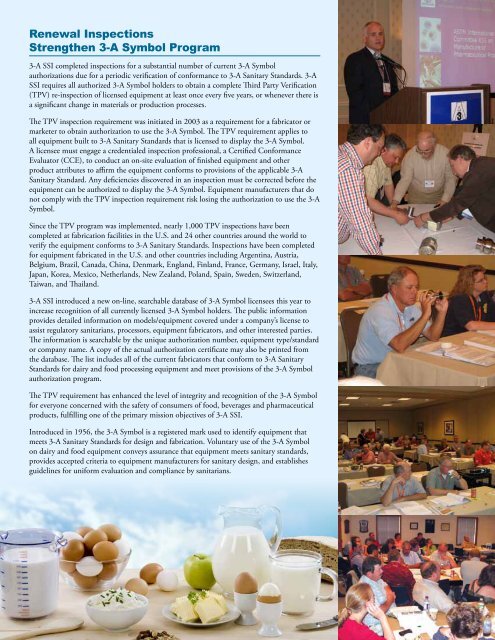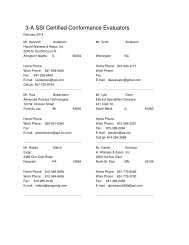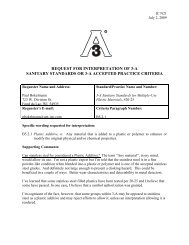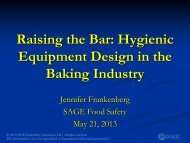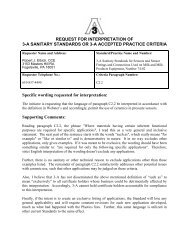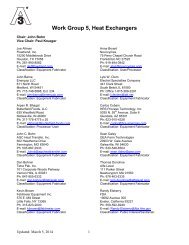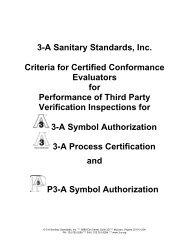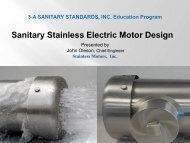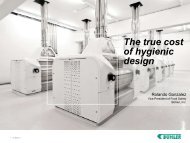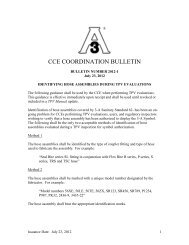2011 Annual Report (PDF) - 3-A Sanitary Standards
2011 Annual Report (PDF) - 3-A Sanitary Standards
2011 Annual Report (PDF) - 3-A Sanitary Standards
You also want an ePaper? Increase the reach of your titles
YUMPU automatically turns print PDFs into web optimized ePapers that Google loves.
Renewal Inspections<br />
Strengthen 3-A Symbol Program<br />
3-A SSI completed inspections for a substantial number of current 3-A Symbol<br />
authorizations due for a periodic verification of conformance to 3-A <strong>Sanitary</strong> <strong>Standards</strong>. 3-A<br />
SSI requires all authorized 3-A Symbol holders to obtain a complete Third Party Verification<br />
(TPV) re-inspection of licensed equipment at least once every five years, or whenever there is<br />
a significant change in materials or production processes.<br />
The TPV inspection requirement was initiated in 2003 as a requirement for a fabricator or<br />
marketer to obtain authorization to use the 3-A Symbol. The TPV requirement applies to<br />
all equipment built to 3-A <strong>Sanitary</strong> <strong>Standards</strong> that is licensed to display the 3-A Symbol.<br />
A licensee must engage a credentialed inspection professional, a Certified Conformance<br />
Evaluator (CCE), to conduct an on-site evaluation of finished equipment and other<br />
product attributes to affirm the equipment conforms to provisions of the applicable 3-A<br />
<strong>Sanitary</strong> Standard. Any deficiencies discovered in an inspection must be corrected before the<br />
equipment can be authorized to display the 3-A Symbol. Equipment manufacturers that do<br />
not comply with the TPV inspection requirement risk losing the authorization to use the 3-A<br />
Symbol.<br />
Since the TPV program was implemented, nearly 1,000 TPV inspections have been<br />
completed at fabrication facilities in the U.S. and 24 other countries around the world to<br />
verify the equipment conforms to 3-A <strong>Sanitary</strong> <strong>Standards</strong>. Inspections have been completed<br />
for equipment fabricated in the U.S. and other countries including Argentina, Austria,<br />
Belgium, Brazil, Canada, China, Denmark, England, Finland, France, Germany, Israel, Italy,<br />
Japan, Korea, Mexico, Netherlands, New Zealand, Poland, Spain, Sweden, Switzerland,<br />
Taiwan, and Thailand.<br />
3-A SSI introduced a new on-line, searchable database of 3-A Symbol licensees this year to<br />
increase recognition of all currently licensed 3-A Symbol holders. The public information<br />
provides detailed information on models/equipment covered under a company’s license to<br />
assist regulatory sanitarians, processors, equipment fabricators, and other interested parties.<br />
The information is searchable by the unique authorization number, equipment type/standard<br />
or company name. A copy of the actual authorization certificate may also be printed from<br />
the database. The list includes all of the current fabricators that conform to 3-A <strong>Sanitary</strong><br />
<strong>Standards</strong> for dairy and food processing equipment and meet provisions of the 3-A Symbol<br />
authorization program.<br />
The TPV requirement has enhanced the level of integrity and recognition of the 3-A Symbol<br />
for everyone concerned with the safety of consumers of food, beverages and pharmaceutical<br />
products, fulfilling one of the primary mission objectives of 3-A SSI.<br />
Introduced in 1956, the 3-A Symbol is a registered mark used to identify equipment that<br />
meets 3-A <strong>Sanitary</strong> <strong>Standards</strong> for design and fabrication. Voluntary use of the 3-A Symbol<br />
on dairy and food equipment conveys assurance that equipment meets sanitary standards,<br />
provides accepted criteria to equipment manufacturers for sanitary design, and establishes<br />
guidelines for uniform evaluation and compliance by sanitarians.<br />
2


